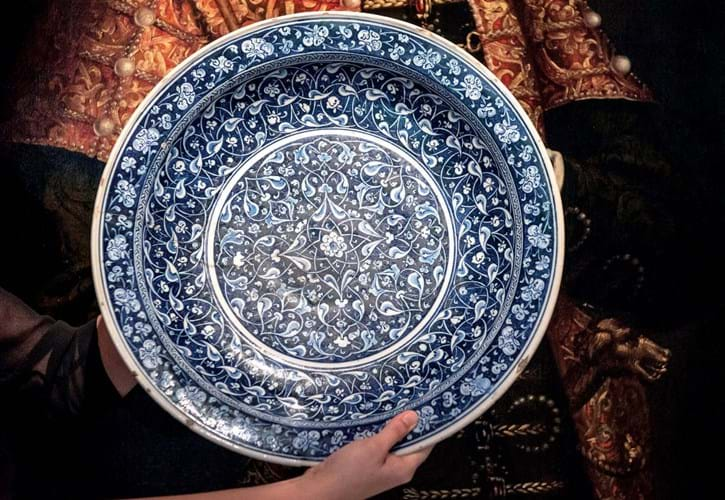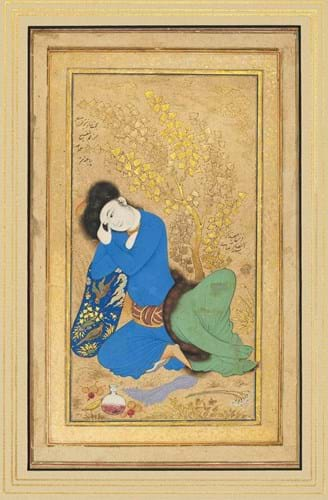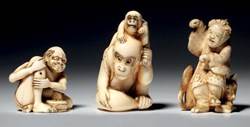
The 18in (44cm) shallow dish – produced at the very advent of the art form in the 1480s – is a lost sibling to four similar large dishes made during the reign of Mehmet II ‘the Conqueror’ that were published in Nurhan Atasoy and Julian Raby’s landmark book Iznik: The Pottery of Ottoman Turkey (1989).
It was formerly owned by the Alexandria-born bibliophile and businessman Max Debbane (1893-1965) and consigned for sale on October 24 from an American private collection.
Nine bidders
The dish attracted nine active bidders at its £300,000-500,000 estimate and at least three combatants on the phone prepared to go above £3m. The bidding contest, won by an institutional buyer, lasted a full 20 minutes. The price ranks as the fourth highest-ever for Islamic art at auction.
Opportunities to acquire works of Iznik pottery from the earliest phase of production are rare and nothing similar has been on the market for more than a generation. Only a candlestick sold at Sotheby’s for a premium-inclusive £616,000 in 1993 and a flask (Sotheby’s 1997) are comparable. The latter is now in the Museum of Islamic Art, Doha - a favourite candidate to be the new owner of the charger.
The previous record for Iznik pottery was the £1.4m bid for a later bowl c.1610 at Christie’s in 2014.
Edward Gibbs, Sotheby’s Middle East chairman, said after the sale: “The fiercely competitive bidding on the Debanne charger was led by a number of eminent institutions as well as private collectors from across the world.
“The new benchmark price of £5.4m was the highpoint of a successful week of auctions which included notable records for Arab and Iranian modern and contemporary artists, many of whom were making their debut on the international stage.”
Sotheby’s catalogue of 20th century Middle Eastern art totalled an above-estimate £2.5m, bringing the firm’s take across two sales to £11.5m.
Sotheby’s second-highest price of the series was a previously unrecorded 14th century Mamluk silver and gold-inlaid brass astrolabe that emerged from a UK private collection, where it had been since 1977, to sell at £230,000.
Made in the astronomy and instrument-making centre of Syria, it is signed and dated for a previously unknown maker - Muḥammad ibn Abi Bakr al-Qawwas - in the year 752 (1351-52AD). One of the four astrolabic plates is original, with the others copied (perhaps in the Ottoman period) from earlier components.
Christie’s October 25 sale titled Art of the Islamic and Indian Worlds included a single-page pigments on paper portrait by the innovative and influential Safavid artist Reza Abbasi (c.1565-1635). The signed depiction of a seated youth measuring 7½ x 4in (19 x 10cm), last sold at auction in 1980, was estimated at £100,000-150,000 but took £420,000. A pendant to a painting called Woman Counting on her Fingers in the Bibliothèque Nationale, it carries the same playful inscription, including the name of the patron for whom it was created, Mirza Muhammad Shafi, and the addition khuddam-i natijatu’l-vuzara’i, translated as ‘one in service to an offspring of viziers’.
The same sale-topping price was taken for a folio from the Blue Qur’an, a luxurious kufic manuscript from 9th century Tunisia that contrasts exquisite gold calligraphy against a black-blue dyed (ahkal) vellum. The folios of this manuscript have now undergone a considerable diaspora: Christie’s had sold two others in April last year for prices closer to the £200,000-300,000 estimate.
El-Gazzar masterwork
Christie’s £3.9m sale of Middle Eastern, Modern and Contemporary Art the previous day was notable for the re-emergence of Abdel-Hadi El-Gazzar’s 1951 masterpiece An Ear of Mud, An Ear of Paste. Much-published, but not seen by the public since the mid-1980s when it was bought in Egypt by US collectors George and Janna Laudato, it topped estimate to sell at £584,750.
Bonhams’ £7.8m Islamic Week sales were dominated by the white-glove performance of 200 pieces from the art collection assembled by private equity company Abraaj Group in the early 2000s.
This collection combining modern Middle Eastern and South Asian art with traditional Islamic and Indian art brought £4.6m. The sale was topped by an untitled oil by New Delhi and London-trained artist Manjit Bawa (1941-2008) that sold for £390,000, having been estimated at £180,000-250,000.
The firm’s £1.8m Islamic and Indian Art sale on October 23 included two items from the famed Lahore Treasury seized by the East India Company at the end of the First Anglo-Sikh War in 1846.
An emerald and seed-pearl necklace once owned by Maharani Jindan Kaur (1817-63), the 17th wife of Ranjit Singh and mother of Duleep Singh, sold above top estimate for £150,000. It was among the jewels boxed in Bombay in 1850 by Frazer and Hawes and sent to London for sale at Garrards. A pair of gold and seed pearl earrings in a similar fitted case from the Maharani's collection sold in the equivalent sale in April for £175,000 including premium.
A ceremonial leather, velvet and gold embroidered quiver and bow holder was probably that made in 1838 for Ranjit Singh, the Lion of the Punjab, to wear at the wedding of his eldest son and heir Kharak. Following its confiscation it came by descent from the First Marquess of Dalhousie, governor general of India from 1847-54. The hammer price was £80,000.

This Mughal emerald seal made for Marian Hastings (1747-1837), the scandal-hit second wife of Warren Hastings, governor general of India 1773-85, sold for a multi-estimate £145,000 at Bonhams.
Among the most popular lots in the sale was a Mughal emerald seal made for Marian Hastings (1747-1837), the scandal-torn second wife of Warren Hastings, governor general of India 1773-85. Estimated at £20,000-30,000, it sold for £145,000.
Born Anna Maria Apollonia Chapuset in Nuremburg, as a young woman she married Baron Christoph Carl Adam von Imhoff but began a relationship with Hastings during a voyage from Dover to Madras in 1769.
This rectangular Colombian emerald, carved with an inscription in nasta'liq script to ‘the one who has the magnificence of the Queen of Sheba’, is dated 1198 (AD1783-4), five years after the couple were finally married and only a year or two before they returned to England in 1785.















